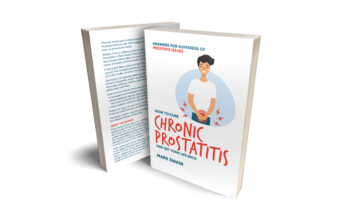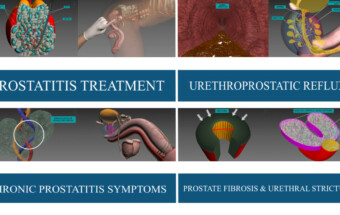What is the impact of calcifications in Chronic Prostatitis and its treatment?
Calcifications due to Chronic Prostatitis
In this post, I will explain in some detail the nature of the calcifications in the prostate, as there are significant misconceptions about them from patients and doctors alike. People often believe that the calcifications are the main cause of the problem and that they constitute the reason why Chronic Prostatitis is difficult to treat, but in truth they are only a side effect and more of an indicator of the chronicity of the disease, rather than an actual causing factor.
In more detail:
The aetiology of the calcifications are chronic infectious and inflammatory processes due to various kinds of microbes in the prostate. Microbes invade, infiltrate and spread into the periurethral and peripheric prostatic glandular ducts, and through them into the stromal tissue which surrounds those glandular ducts.
Due to the chronic inflammatory processes, a series of various kinds of degenerative changes take place into the prostatic ducts and their stromal tissue, and as a consequence (among the other reactions and changes), there is an impregnation with calcareous matter which means abnormal deposition of calcium salts. This deposition takes place:
- Within the soft prostatic stromal tissue, often causing more thickening and/or hardening of the stromal area which leads to different grades of strangulations and deformations in the prostatic ducts, vessels, lymphatics and nerves.
- Inside the prostatic glandular ducts, where deposition of different calcium salts are added on top of the liquid viscous mass consisting of pus, fluid of degenerated tissue, cell debris, dead leukocytes and prostatic fluid which will remain as a creamy yellow pus that blocks further the flow of prostatic fluid inside the ducts, finally leading to the transformation of small abscesses in a certain fields of the prostate gland but mainly in the periurethral glandular area due to the “snake” shape and configuration of these glands.
To sum up, the calcified areas (especially around the urethral prostate zone), are simply calcium salts impregnations of an already chronically inflamed tissue, which became hard (before the calcification) due to fibrotic and/or sclerotic changes in the tissue as a result of the chronic inflammatory process.The hardened tissue may become harder in some spots due to the calcium depositions, but the main problem happens before the calcification takes place. In simpler terms, it is the equivalent of throwing a layer of “paint” on an already hardened concrete wall – clearly, the problem is the wall and not the paint.
Are calcifications “inaccessible” areas?
The answer is no, they are not inaccessible. The microbes inside all these structural and functional tissue formations can feed, can infiltrate and invade the surroundings areas and all these through the microcirculation that still exists, despite it being compromised due to what we mentioned above. Thus, the antibiotics can reach those areas but in so small concentrations almost incapable to kill even a small number of microbes but good enough to give the microbes the ability to create resistance to them.
My protocol leads to a solution because it focuses (among other things) on dissolving all these hard areas which actually consist of:
- Chronic inflammatory fibrotic-sclerotic tissue impregnated with calcium salts
- Strangulated vessels, lymphatics and nerves with compromised functionality
- Glandular ducts which are obstructed with pus and thus are incapable to do their function which is the normal flow of prostatic fluid (through them) produced from the glandular component of these ducts.
The greatest challenge and the most demanding task is to achieve all the above in the hardest and smallest obstructed abscesses (i.e. cysts containing pus) around the periurethral prostate zone, which actually contains the microbes that invaded the prostate tissue in the beginning (i.e. the first infection). These microbes create the conditions which make the subsequent contaminations with other microbes easier and they may not even be visible by the time the patient gets checked as typically patients visit the doctor a year or two after the initial infection, by which time they will already be in “fortified” areas, and thus not likely to be released in the samples (unless specifically forced to). What most patients typically see in their microbiological tests (assuming they are executed correctly) are usually the latest microbial infections / invasions which are on the periphery of the prostate and as such they are more likely to get released in the samples. Again, this is assuming that the ducts in which the microbes are located, are not yet totally obstructed.
The oldest microbes are the most difficult to remove in order to reach full cure, not only due to their difficult location in the prostate but also due to their ability to absorb slowly but constantly small quantities of antibiotics given throughout the multiple therapies over time, which gradually make them resistant to most of them.
This is also the reason why my protocol is organized in two or three stages since we have to know exactly what kind of microbes we have to deal with and their resistances, but these microbes may not even be visible until we reach the areas closer to the urethra, which usually happens mid-therapy. This is also the reason, why we may find microbes during or even post the first and / or second stage(s) of the protocol, as they could be hidden in small cystic formations (i.e. obstructed prostatic ducts) that we just happen to release at that treatment session.
So, by now it should be clear that the difficulty of treating Chronic Prostatitis does not depend on whether the prostate contains calcifications or not, nor purely due to the distorted microcirculation, but for the complex reasons we have mentioned above.
And for this reason, the Georgiadis Protocol aims to:
- Liberate and restore the vessels’ microcirculation which in turn will increase blood flow, oxygen and antioxidative agents which will aid in the regeneration of the tissue once the microbes are cleaned up.
- Through the improved microcirculation to increase the concentration of antibiotics and agents of the immune system. In turn, the immune system agents will gain the ability of approximation and recognition of the microbes’ sites and thus will be able to aid in their complete elimination.
- Undo the strangulation of the endoprostatic neural plexus network which in turn will gradually deconstruct the symptoms.
- Lead to the total release of the obstructed prostatic ducts, thus restoring the healthy flow of prostatic fluid.
- Soften the periurethral chronic inflammatory fibrotic – sclerotic tissue which led to the periurethral stricture, which in turn caused decreased urinary flow along with endoprostatic urine reflux. The therapy outcome is elastic, moist and functional tissue, which consequently restores the previously compromised urinary flow and of course stops the endourethral / endoprostatic urine reflux.



